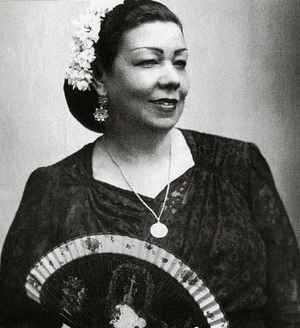


La Niña de los Peines 1941
Source: America Pink
La Niña de los Peines, The Girl of the Combs, was a gypsy born Pastora Maria Pavón Cruz on 10 February 1890 in Seville, Spain. Never learning to read nor write, nor learning to sign her name until an adult, La Niña de los Peines began performing at the theatre, Taberna de Ceferino in Seville, toward supporting her family. She would pick up the name, the Girl of the Combs, due to a tango she often sang as to her combs made of cinnamon.
After touring Spain a bit, Pastora made her debut recording on an unidentiified date in autumn of 1809, 'Tarantas', on matrix Y-857 toward issue on Zonophone X-5-53.009 [Maldonado]. Matrix Y-158 was 'Cartageneras' issued on Zonophone X-5-53.015. Matrix Y-159 was 'Solearas' released on Zonophone X 5-53016. Y-160 was 'Tientos' going down on 19 December 1909 [DAHR]. DAHR lists three more titles reflecting genres of flamenco following the next day: 'Solea', 'Buleria' and 'Sevillanas Boleras' (No.1). All of Peines' recordings are titled by forms of flamenco, further distinguished by subtitles by Allen Kelly which are often but not always incipits. For example, Pastora's initial 'Tientos', which is a slow form that finishes in in tango, is subtitled 'A mi mi mare me bendijo'. Later 'Tientos' titles are distinguished by numbers and subtitles. The tientos is something like a fantasia which generally refers to a free departure from (prescribed) form, such as (in) a tango. Though Pastora's' first records were issued on Zonophone, that company was in business only from 1899 to 1903 when its name was acquired by Columbia, then Victor, then Gramophone/EMI [Wikipedia].
'Tarantas' ('De Noche y Día' 'Of Night and Day')
La Niña de los Peines w Ramon Montoya (guitar)
Recorded sometime latter 1909 in Madrid Matrix Y-857
Issued on Zonophone X-5-53.0009
'Tientos' ('A mi mi mare me bendijo' 'My Mother Blessed Me')
La Niña de los Peines w Ramon Montoya (guitar)
Recorded 19 Dec 1909 in Madrid Matrix Y-860
Issued on Zonophone X-5-53.010 Victor 65208 Gramophone 3-63014 / 553010 / 653040
The various types of flamenco are known as palos which can be categorized via cante (grande, intermedio or chico) or via family of origin and rhythm type such as the solea and buleria mentioned above. Others include tonas, fandangos and tangos as mentioned above in relation to tientos. Flamenco is also more specifically classified according to region of origin. A Cartagenera, for example, has its origins in Cartagena, while a Sevillana first sprung its leak in Seville. Titles or subtitles below are rendered per the 2004 compilation by Junta De Andalucía called 'Patrimonio De Andalucía'.
'Tango de Cadiz' ('Salomón con ser tan sabio' 'Solomon to Be So Wise')
La Niña de los Peines w Manolo de Badajoz (guitar)
Recorded or issued 1929
'Tango de Cadiz' is a tientos per QuintoSertorio
'Fandangos' ('Que los besos de una madre' 'The Kisses of a Mother')
La Niña de los Peines w Nino Ricardo (guitar)
Issued 1932 on Regal DK 8693
Pastora''s favorite non-gypsy artist was Antonio Chacon whose cantes she began to record for Polydor after his death in 1929. She married flamenco singer, Pepe Pinto, in 1931, 1933 or 1936 depending on the source. During the Spanish Civil War they took refuge in Madrid from 1936 to 1939, after which they took up residence in Seville through World War II as her career began its decline. She and Pinto appeared in her last theatre production, 'España y su cantaora', in 1949, followed by her final recordings in 1950.
'Tango' ('Al Gurugu')
La Niña de los Peines w Melchor de Marchena (guitar)
Recorded 1946 Issued on La Voz De Su Amo AA 283
'Bulerías': 'Cielito Lindo' ('De Cien Dificultades' 'One Hundred Difficulties')
La Niña de los Peines w Pepe Pinto 1949
Composition: Quirino Mendoza y Cortés 1882
Pastora made a final appearance in 1961 which got recorded at an homage held for her by various flamenco artists:
'Bulerías' La Niña de los Peines w Pepe Martinez (guitar)
Recorded live in Cordoba 1961
In December of 1968 a statue of Pastora was erected in the Alameda de Hércules in Seville. She died on 26 November 1969 only 20 days after the death of her husband, Pepe, on 6 November, of which she was unaware. She had issued about 355 records in all.
Sources & References:
VF History (notes)
Anita Volland
Audio: Internet Archive
La Niña de los Peines & Antonio Chacon: Expo Flamenco
Filmography: IMDb
Iconography: Wikimedia Commons
Lyrics: Al Gurugú (1946)
Palos (flamenco categories): Wikipedia
Recordings of La Niña de los Peines:
Cats & Discos:
Compilations:
The First Recordings (1995 on Mandala MAN 485)
Patrimonio De Andalucía (1910-1950 by Junta De Andalucía 2004)
Sessionographies:
DAHR (1909/1911/1927)
Antonio Hita Maldonado (El flamenco en la discografia antigua / U de Sevilla 2002)
Further Reading:
Reviews of La Niña de los Peines: Junta de Andalucia
Classical Main Menu Modern Recording
hmrproject (at) aol (dot) com